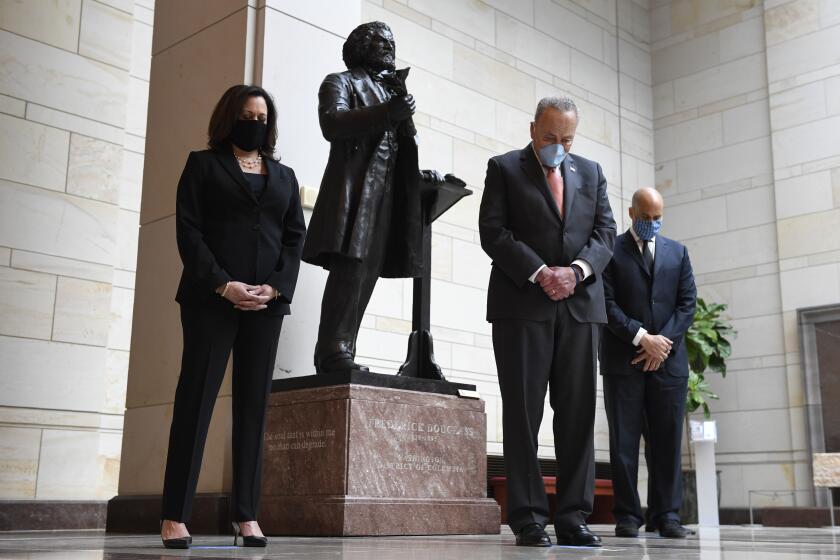Judgments about a chief justice
Ten years after Chief Justice Ronald M. George became head of California’s courts and dramatically transformed the state’s judicial branch, many Los Angeles judges remain resentful of their loss of power and control.
Atty. Gen. Bill Lockyer, a Democrat, calls the Republican George “the best chief justice in California history.” Some judges in Los Angeles have another name for him:
“King George.”
It is a measure of their distrust that few of George’s critics would permit themselves to be quoted by name. Privately, they accuse George of building a judicial empire by centralizing administrative power in an ever-growing state bureaucracy.
The resulting conflicts have ranged from whether Los Angeles is getting its fair share of judicial funding to who decides the color of the backings of legal briefs.
Few court users are aware of the tensions. L.A. courts, like others across the state, have enjoyed increased funding under George, although the hike in Los Angeles, where caseloads have been flat for eight years, is less than in growing counties like San Bernardino and Riverside.
But the acrimony threatens to undercut George’s campaign to make the courts uniform from county to county, and to speak with one voice when seeking new judgeships and more money.
Under George, the Legislature approved the transfer of courts from county to state control. The San Francisco-based Administrative Office of the Courts, a once obscure agency with few duties, has ballooned as it implements ambitious policies set by the Judicial Council, the courts’ policymaking body that George heads.
Since George became chief, the office has more than doubled its staff to 600, opened branches in Sacramento and Burbank and, according to some L.A. judges, created “opulent” offices with “plasma TVs.”
The goal was to create a unified judicial branch with stable funding. But many Los Angeles judges, accustomed to calling the shots, chafe at having the purse strings shifted from the L.A. County Board of Supervisors, a short walk from the downtown courthouse, to San Francisco, where the Administrative Office takes up five floors in a state building and where L.A. is just one of 58 courts vying for attention.
“All of a sudden this new state organization has the ultimate control technique -- budget power -- so the troops down in the trenches aren’t necessarily thrilled,” said an L.A. judge who declined to be identified.
Los Angeles Superior Court Judge Robert Dukes, one of the few jurists willing to talk for attribution, said most courts in California have probably benefited from George’s changes. But the Los Angeles court enjoyed good relations with the county and probably would have fared better under county control, he said.
It is impossible to determine whether Dukes is correct. Funding for the trial courts rose 89% under George, according to the Administrative Office, while the increase for Los Angeles was 60.5%, according to an L.A. court spokesman.
During the same decade, the Administrative Office budget grew by at least 74%. The exact amount is unclear because of the way the office calculates its budget.
George’s fans, and they are many, maintain that the L.A. jurists resist change, even when it would save money, and criticize new policies even when fellow L.A. judges help craft them.
“They are always dragging their heels,” said Christine Hansen, head of the Administrative Office’s finance division.
From the start, George set out to make courts “user-friendly,” declaring they were for the people, not the lawyers and judges.
“I have tried to create a strong and independent judicial branch that can resist pressure from the other two branches and have financial independence,” said George, a former L.A. judge who spends time in San Francisco and maintains a home in Los Angeles County.
When George became chief justice in 1996, he visited all of California’s 58 counties. He observed rat-infested, overcrowded and crumbling courthouses, one so cramped that a broom closet sufficed as a judge’s chambers.
“The courts were going belly-up,” George said.
Overworked judges in some Superior Courts had trials backed up for years, whereas under-worked judges in Municipal Court went home early, George said.
Under George, all of the courts became Superior Courts. Responsibility for the courthouses is gradually shifting to the state, and state money is doled out by the Administrative Office, which has taken over accounting, technology, human resources, contracting and legal support responsibilities from the counties.
George “is perhaps the most effective administrative chief justice in the history of California,” said Court of Appeal Justice Norman Epstein, a judge for 26 years. “The thing he has set out to do -- and has accomplished -- in his 10 years is just extraordinary.”
But the shift of authority, in the eyes of some L.A. judges, has meant less respect for traditions that reflect Los Angeles’ unique legal culture and less local control.
Although George is regarded as a tireless lobbyist for the courts, including judicial salaries, one jurist charged that much of George’s work has been aimed at “legacy building” for himself.
The judge, speaking only on condition of anonymity, insisted that George and William C. Vickrey, head of the court administration office, keep an “enemies’ list” and retaliate when crossed.
The judge pointed to a press release for a gathering at a San Francisco hotel to celebrate the Administrative Office’s 80th anniversary.
“Now, why are they having an 80th-birthday party? Oh, their PR is amazing.”
Another judge complained that “staff is starting to run this branch, rather than the judges.”
“They created a huge office in Burbank with modern plasma screens where we can’t even get overhead projectors,” the jurist said. “It’s embarrassing.”
George called the enemies list allegation “laughable.” He said he was aware of the “resentment” of a “small, vocal minority” of Los Angeles judges and sympathized with them.
“Judges are trained and steeped in precedent, which makes many of them resistant to change, and we have brought a lot of change in the last decade,” George said in an interview in his chambers across the street from San Francisco City Hall.
In the infamous battle of the “bluebacks,” many L.A. judges fumed when George’s Judicial Council prohibited them from requiring lawyers to file documents with a traditional blue backing. The practice made it easier for the judges to sift through files.
The Judicial Council ended the requirement in 1997 to bring uniformity from courthouse to courthouse. For years, a few stubborn L.A. judges continued to post signs saying they preferred “bluebacks.” One courtroom sign remains.
Adding to the tension, George took away from the L.A. judges the task of writing jury instructions. The copyrighted instructions earned as much as $700,000 a year for the Los Angeles court and gave its bench influence.
George wanted the instructions in plain English that jurors could understand. The L.A. judges resisted and declined to participate in the overhaul, George said.
The new instructions have won national awards. And they’re free. “Innocent misrecollection is not uncommon,” judges once advised. Now they tell jurors, “People sometimes forget things.”
“That was a big event,” said Court of Appeal Justice Paul Boland, a former L.A. trial judge, “because that was perceived by some judges in Los Angeles as uniquely and personally affecting them.”
George also irked the L.A. judges when he once described them as “double-dipping for benefits.” Los Angeles judges receive benefits packages from both the state and the county, and usually cash one in for an additional $30,000. George said he supported legislation to preserve the arrangement.
Asked whether George was partly to blame for the antipathy, Boland said: “There is a question of whether a more measured approach might not have produced some of the tensions.”
George conceded he may have tried to do too much too fast but said he had to act while the Legislature and the governor’s office were receptive.
Just this year, the Judicial Council, which George heads, caused a fracas by proposing mandatory continuing education for judges, a requirement in other states. A fervent backlash that included letters from angry judges led the Judicial Council to compromise with a rule that said jurists were “expected” but not required to continue their legal education. Some of the most vocal opponents were on the L.A. bench.
Los Angeles Presiding Judge William A. MacLaughlin said judges in other counties share the L.A. court’s concerns, but L.A.’s response is magnified because its judges represent one-third of the state’s bench.
MacLaughlin acknowledged feeling micromanaged at times. The Judicial Council passes rules “that tell judges in very specific detail how they are supposed to perform their duties.”
“Judges think they should have more discretion,” MacLaughlin said
Sheila Calabro, the administrative officer for the court’s southern region, gave a reporter a tour of the much-derided Burbank administrative branch -- well-appointed but hardly lavish conference rooms, offices and cubicles close to the airport. She said the courts frequently use the $67,342-a-month center for meetings and training.
“I like to say, ‘Mi casa es tu casa,’ ” said Calabro, who has worked in court administration for three decades.
As for the plasma TVs, the office has two sets of flat-screens used for video conferencing. “You can’t watch television on them,” Calabro said.
Calabro suggested a simple explanation for the L.A. judges’ criticisms. “Who wants to have a boss?”
*
(BEGIN TEXT OF INFOBOX)
Chief Justice Ronald M. George
Age: 66
Education: Stanford Law School, 1964; Princeton University undergraduate degree, 1961.
Family: Married, three children.
Residence: Maintains homes in San Francisco and Los Angeles County.
Politics: Republican moderate, frequently compared to U.S. Supreme Court Justice David Souter.
Judicial positions: Appointed by Gov. Ronald Reagan to Los Angeles Municipal Court on April 20, 1972.
* Elevated to Los Angeles Superior Court by Gov. Jerry Brown on Dec. 23, 1977; presided over the trial of “Hillside Strangler” Angelo Buono.
* Appointed to the Court of Appeal by Gov. George Deukmejian on July 23, 1987.
* Appointed to the California Supreme Court by Gov. Pete Wilson on July 29, 1991.
* Elevated, also by Wilson, to chief justice on March 28, 1996. He is the 27th person to hold the position in California history.
Los Angeles Times
More to Read
Get the L.A. Times Politics newsletter
Deeply reported insights into legislation, politics and policy from Sacramento, Washington and beyond. In your inbox three times per week.
You may occasionally receive promotional content from the Los Angeles Times.











